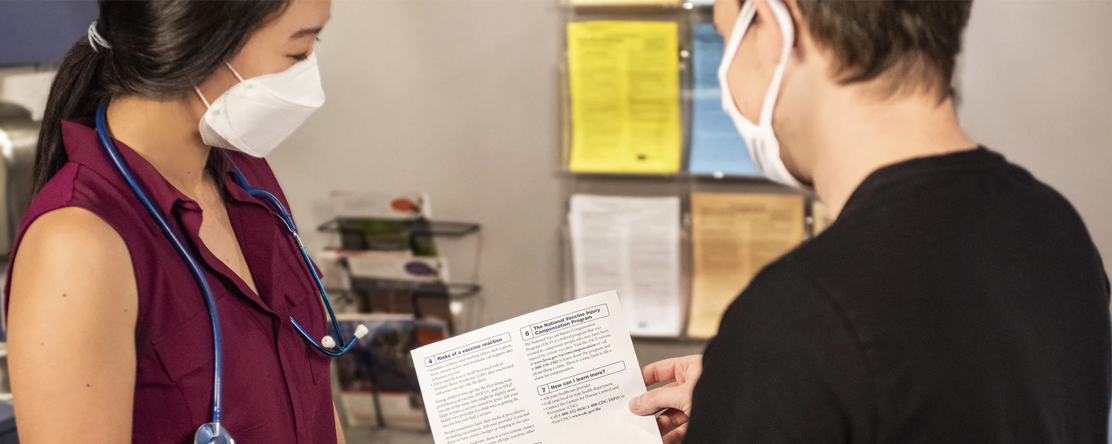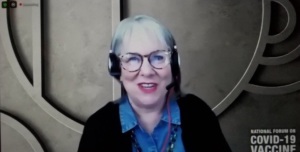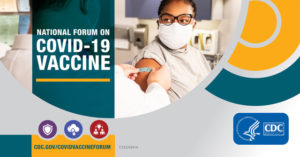
Update
From Misinformation to Missing Infrastructure: Overcoming Barriers to COVID-19 Vaccination
-
Focus Areas
Communicable Disease Prevention -
Programs
Berkeley Media Studies Group -
Strategic Initiatives
COVID-19

After more than a year of mask-wearing, social distancing, and Zooming, we are finally gaining momentum in the fight against COVID-19. News of the vaccine should be a sigh of relief, and the daily pace of vaccinations continues to rise. I know I felt better this week when my parents, both in their late 80s, got their second dose. Yet I haven’t felt the nation exhale. Why not?
On the one hand, people are clamoring for their shots. Sports teams have opened up their stadium parking lots, complete with their crowd management expertise, to get more doses in more arms, even when protesters try to disrupt the dedicated health workers giving vaccines. On the other hand, we hear regularly about COVID-related misinformation, with news outlets warning about its online proliferation, even with public health departments and their community partners diligently informing the public with scientifically sound information about the virus and the vaccine.
Yet, despite the misinformation, the main problem is creating the infrastructure to deliver the vaccine, not persuading people to get it.

Headlines about misinformation and vaccine hesitancy may be overshadowing the bigger problem of structural barriers and a fractured health care system, which are major reasons why members of Black, Indigenous, Latinx, Asian Pacific Islander, and other communities of color — among those hardest hit by COVID-19 — have not received their share of vaccines.
To be sure, people have questions about the vaccine itself, its development, and about our medical care system. Their questions need to be acknowledged and answered. We can often do this with a relatively simple, straightforward message.
As Kate Grabowski, an epidemiologist at Johns Hopkins, told the New York Times, the vaccine message should be: “They’re safe. They’re highly effective against serious disease. And the emerging evidence about infectiousness looks really good. … If you have access to a vaccine and you’re eligible, you should get it.”
We could get further faster if we in public health were better at sharing this message. At the same time, we can also acknowledge the complicated history behind vaccine hesitancy and point to structural factors that keep the vaccine out of reach for many people, like not having internet access, translated instructions, or adequate transportation.
Building trust in public health
In Black communities especially, the hesitancy is well-founded. Research has documented serious and persistent structural and interpersonal racism in public health and health care, from the Tuskegee study that withheld treatment from African American men with syphilis so scientists could watch how the disease progressed to the disparate health outcomes that can be traced to racism within and outside of the health care system.
Acting to correct this history is as vitally important as communicating about it. This is where actions speak louder than words. Building trust among community residents, the organizations that represent them, and medical providers is key. It is a process that takes time and support.
Consider what happened when Black community leaders and medical professionals joined forces in West Philadelphia to eliminate the transportation, registration, and other structural barriers to bring vaccines directly to the people: 500+ residents were vaccinated at a church vaccine clinic in one day.
The more we see stories like these, highlighting people getting vaccines, the more the public’s confidence in vaccination grows.
 Last week at the CDC National Forum on COVID-19 Vaccine, I got to query experts about countering misinformation. During our Town Hall (which will be available on the CDC’s website), they drew on behavioral and social science to remind us that the tenets of good strategic communication apply to COVID, too.
Last week at the CDC National Forum on COVID-19 Vaccine, I got to query experts about countering misinformation. During our Town Hall (which will be available on the CDC’s website), they drew on behavioral and social science to remind us that the tenets of good strategic communication apply to COVID, too.
For example, trusted messengers are just as important as the message. That’s why it’s critical to hear from a range of voices in news coverage, including from people who have received the vaccine, and to provide them and the organizations they work with resources to share their messages. The panelists also reminded us that misinformation thrives in a vacuum, so our message that COVID shots are safe and effective needs to be loud, clear, and frequent.
And, crucially, if the mechanisms for getting the vaccine into people’s arms aren’t in place, then our message — no matter how well-planned — won’t matter.
Originally published by Berkeley Media Studies Group
More Updates
Work With Us
You change the world. We do the rest. Explore fiscal sponsorship at PHI.
Support Us
Together, we can accelerate our response to public health’s most critical issues.
Find Employment
Begin your career at the Public Health Institute.



